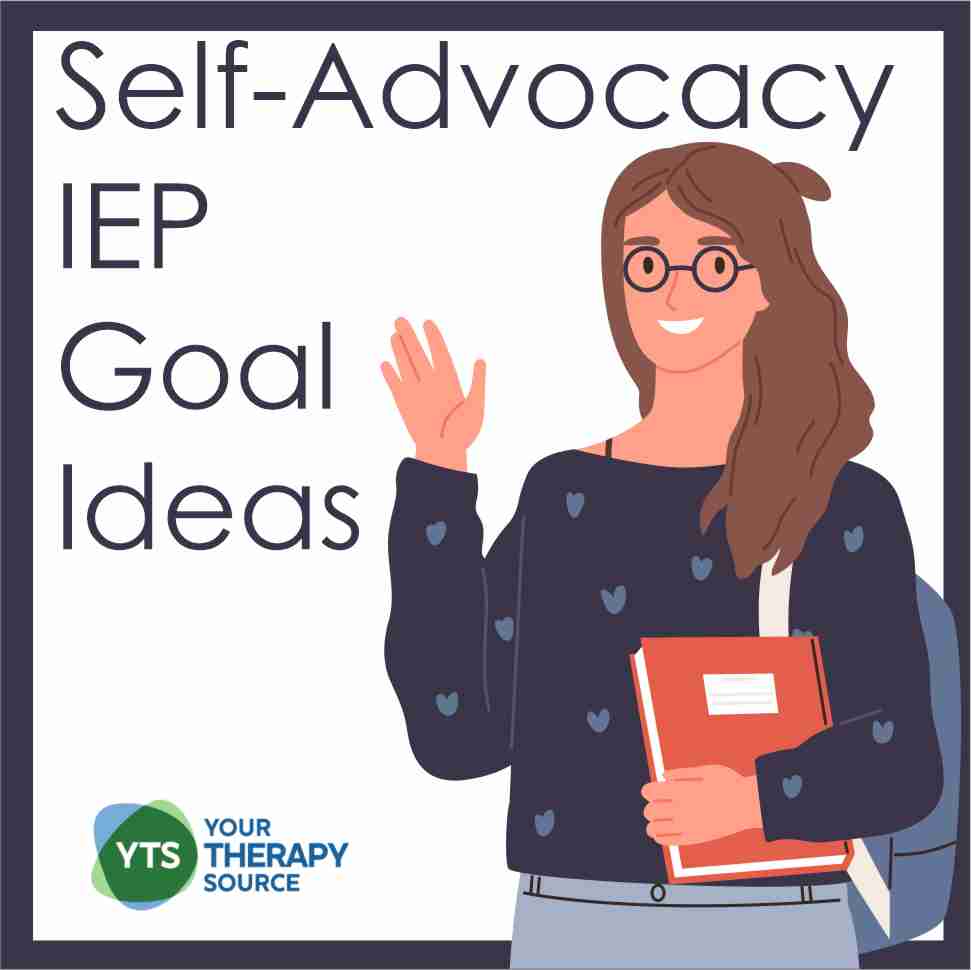SELF ADVOCACY IEP GOALS

As a teacher, you always want what’s best for your students. But when it comes to IEP goals, sometimes it can be tough to know the best path for each student. One way to help ensure that your students’ individual needs are met is by helping them learn to advocate for themselves. Here are some ideas on how to get started with self advocacy IEP goals.
WHAT ARE SELF ADVOCACY IEP GOALS?
Self advocacy IEP goals are those that focus on helping the student learn to advocate for him or herself. It means that students learn how to identify for themselves what behavioral and academic classroom goals they need to accomplish. These goals also help the student understand why this type of goal setting is essential and how to achieve their goals.
WHY ARE THESE GOALS IMPORTANT?
Students need self advocacy goals in their IEPs so that they can take control of their education and ensure that their individual needs are being met. When students know how to advocate for themselves, they are more likely to be successful in school and in life.
These skills are important for all students, but they can be especially critical for those with physical or learning disabilities. Self advocacy IEP goals can help your student become more independent and self-sufficient as he or she grows older. Additionally, self advocacy skills can help your student to communicate more effectively with teachers, parents, and other important adults in his or her life.
WHAT ARE THE AIMS OF SELF ADVOCACY IEP GOALS?
These types of goals should be aimed at helping the student become a more effective advocate for him or herself. This might include things like:
- Learning to communicate their needs in an effective way
- Taking the opportunity to speak up for themselves in front of others
- Learning to navigate the IEP process
- Understanding self-monitoring for behavior and academics
WHAT ARE SOME EXAMPLES?
Effective IEP goals should be specific, measurable, achievable, relevant, and time-bound (SMART). Additionally, they should be based on the student’s individual needs. Some examples of these goals might include:
- By April, the student will learn 2 strategies to advocate for him or herself.
- By January, the student will demonstrate the ability to ask for help when needed 100% of the time.
- At the end of the first quarter, the student will determine one or two environmental requirements (ex: I need movement breaks every 20 minutes; I require a peaceful environment to work)
- By June, the student will participate in goal-setting meetings and help with the creation of educational goals.
- By the end of the second quarter, the student will be able to identify 2 specific environmental modifications and understands why they are necessary.
- Before the end of the school year, the student will participate in 3 IEP meetings by speaking up about her educational needs.
- By June, the student will be able to request a curriculum change and will ask for one with some adult guidance.
- By the end of the school year, the student will learn to navigate the IEP process, with minimal assistance from adults.
- By June, the student will identify 5 areas of strength.
- The student will self monitor progress to determine if a modification is helping them to meet their learning goals.
HOW TO WRITE SELF ADVOCACY IEP GOALS
When goal setting for self advocacy on an IEP, it is important to keep the student’s individual needs in mind. They should also be based on the student’s current level of functioning.
Some tips for writing self advocacy IEP goals include:
- Make sure the goal is student-centered. Self advocacy IEP goals should be about what the student can do, not what adults can do for the student.
- Keep it simple. Self advocacy IEP goals should be clear, concise, and use appropriate language.
- Make it realistic. These goals should be achievable for the student.
- Ensure that it is specific. They should be focused on a specific skill or area of need.
- Be sure it is timely. Each self advocacy goal should have a timeframe for completion.
HOW CAN I HELP MY STUDENT ACHIEVE THESE GOALS?
There are a number of things that you can do to help your student achieve their self advocacy IEP goals. Some things that you might consider include:
- Providing opportunities for the student to practice self advocacy skills in safe and supportive environments.
- Helping the student to understand their rights and responsibilities under the Individuals with Disabilities Education Act (IDEA).
- Teaching the student about how to effectively communicate their needs to others, and monitor their own behaviors.
- Modeling self advocacy skills for the student in your own interactions with school staff and other adults.
- Encouraging the student to participate in making decisions about their education, including setting and reviewing their IEP goals.
HOW DOES SELF ADVOCACY AFFECT STUDENT BEHAVIOR?
Self advocacy skills can help students to effectively communicate their needs and wants. As a result, self advocacy can positively impact student behavior. When students feel like they are being heard and their needs are being met, they are more likely to be engaged in learning and less likely to act out with negative behaviors. Self advocacy skills can also help students to develop a sense of ownership over their education and to feel more confident in their ability to achieve their goals. They gain self-awareness of their own goals.
Social and emotional learning also improve when students learn to self advocate. By teaching self advocacy skills, you can help your students to develop the ability to manage their emotions, set goals, and advocate for themselves. They develop emotional regulation skills. Self advocacy strategies can also help students to build positive relationships with their peers and adults.
HOW TO MEASURE SELF ADVOCACY IEP GOALS
An IEP team can measure self advocacy goals in a number of ways, and with a variety of resources including:- Observations: Parents, teachers, and other adults can observe the student to see if he or she is using self advocacy skills in different situations.
- Self-report: The student can fill out a questionnaire or survey about his or her experiences with self advocacy.
- IEP documentation: Special education teachers can document the student’s progress towards meeting these goals in the IEP itself.
- Parent/teacher report: Parents and teachers can fill out a questionnaire or survey about the student’s progress in self advocacy.
- Parent/teacher conference: The special education or classroom teacher can meet with the parent to discuss student progress, and gain the support of the parents.
Self advocacy IEP goals should be specific, measurable, achievable, relevant, and time-bound when used in educational programming. By using these criteria, you can ensure that your student’s self advocacy goals are realistic and attainable. Furthermore, you can use different methods to measure the student’s progress toward meeting their self advocacy IEP goals. Students will develop an understanding of the goals as well.
Self advocacy is an important skill for all students to learn. By writing self advocacy IEP goals, you can help your student to develop the skills that he or she needs to be successful in school and in life.
My Goal Tracker – Student Generated Data Collection

RELATED RESOURCES
Working together, your students will learn new skills to use in their daily routines for life long success!




